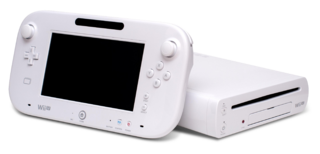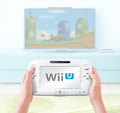Wii U
From Sega Retro

| ||||||||||||||||||||||||||||||||||||||||

| ||||||||||||||||||||||||||||||||||||||||
| Wii U | ||||||||||||||||||||||||||||||||||||||||
|---|---|---|---|---|---|---|---|---|---|---|---|---|---|---|---|---|---|---|---|---|---|---|---|---|---|---|---|---|---|---|---|---|---|---|---|---|---|---|---|---|
| Manufacturer: Nintendo | ||||||||||||||||||||||||||||||||||||||||
|
The Wii U, codenamed Project Café, is a Nintendo video game console announced at E3 2011 as the successor to the Wii and released in 2012. It became infamous for being the worst selling Nintendo console due to a number of factors such as poor marketing decisions. It was succeeded by the Nintendo Switch in 2017.
Contents
Overview
Because of the Wii being catered to the "casual" market due to its lack of HD capability and limited network infrastructure, the main focus of the Wii U was to appeal to "core" gamers. Game designer Shigeru Miyamoto envisioned the concept of the new system's controller having an embedded touch screen, which was originally going to be a small screen to provide game feedback and status messages to players (similar to the Sega Dreamcast's VMU), but later changed to a full screen that can display a game in its entirety.[1] This controller would essentially become the Wii U GamePad, which can be used either as a supplement to the main display or in supported games to play the game directly on the GamePad, with a Wii U Pro Controller provided as a more traditional alternative. The GamePad also supports NFC to allow the system to wirelessly interact with figurines and cards, which was ultimately used for amiibo.
The system launched in two bundles: the Basic bundle and the Deluxe/Premium bundle. The Basic bundle is white and has 8 GB of internal storage, while the Deluxe bundle is black with 32 GB storage and a copy of Nintendo Land. The system used its own online infrastructure known as Nintendo Network, which also came with its own integrated social media platform known as Miiverse. The system is also backwards compatible with all Wii titles and various Wii accessories, with Wii games running in a virtual environment commonly referred to as "Wii Mode" or "vWii".
The Wii U was first met with a generally positive reception, which included praise for its innovative GamePad controller, improvements to online functionality over the Wii, backwards compatibility with existing Wii software and peripherals, and relative affordability. However, after the system was launched, criticisms rolled in over issues such as the GamePad's short battery life and issues with the console's user interface and functionality, a weak lineup of launch titles, very limited third-party support and poor marketing. As a result, the console struggled to live up to expectations, leading to slow consumer adoption and the system only achieving a total of 13.56 million units sold worldwide (as of 31 March 2017)[2], the lowest of any Nintendo home console so far. Production of the Wii U officially ended in January 2017.
Sega support
Similarly to the Wii, many big publishers, including Sega, were optimistic about the Wii U in its first few months of sale, however the console's inability to live up to expectations and a restructured Sega growing ever more disconnected with full price video game console releases meant that far fewer Sega games were published for the Wii U than its predecessor. Sega have even declined to support the Wii U's Virtual Console service apart from only a handful of Game Boy Advance games that only saw release in Japan.
Sega's main contribution to the Wii U game library consisted of an exclusivity deal regarding the Sonic the Hedgehog franchise. This materialised in the form of Sonic Lost World and the critically panned Sonic Boom: Rise of Lyric, among continued entries in the Mario & Sonic at the Olympic Games series. Other contributions were small or Japanese-only, with the firm taking only an advisory role in Bayonetta 2, a Wii U-exclusive sequel to the 2009 original. The company published games for the console until 2014.
List of Sega games for the Wii U
- Bayonetta (2014)
- Bayonetta 2 (2014)
- The Cave (2013)
- ChuChu Rocket! (?)
- Citizens of Earth (2015)
- Cryamore (?)
- Mario & Sonic at the Rio 2016 Olympic Games (2016)
- Mario & Sonic at the Sochi 2014 Olympic Winter Games (2013)
- Puyo Puyo Tetris (2014)
- Ryuu ga Gotoku 1&2 HD Edition (2013)
- Shining Force: Resurrection of the Dark Dragon (?)
- Shining Soul (?)
- Shining Soul II (?)
- Sonic & All-Stars Racing Transformed (2012)
- Sonic Advance (?)
- Sonic Advance 2 (?)
- Sonic Advance 3 (?)
- Sonic Boom: Rise of Lyric (2014)
- Sonic Lost World (2013)
- Super Smash Bros. for Wii U (2014)
- Tokyo Mirage Sessions ♯FE (2015)
- Trauma Team (2015)
In addition, the Game Boy Advance games Sonic Advance, Sonic Advance 2, Sonic Advance 3, ChuChu Rocket!, Shining Force: Kuroki Ryuu no Fukkatsu, Shining Soul and Shining Soul II are available on the Wii U's Virtual Console service in Japan.
Promotional images
References
| Non-Sega consoles |
|---|
| Nintendo |
| Nintendo Entertainment System (1983) | Game Boy (1989) | Super Nintendo Entertainment System (1990) | Nintendo 64 (1996) | Game Boy Color (1998) | Game Boy Advance (2001) | Nintendo GameCube (2001) | Nintendo DS (2004) | Wii (2006) | Nintendo 3DS (2011) | Wii U (2012) | Nintendo Switch (2017) |
| Sony |
| PlayStation (1994) | PlayStation 2 (2000) | PlayStation Portable (2004) | PlayStation 3 (2006) | PlayStation Vita (2011) | PlayStation 4 (2013) | PlayStation 5 (2020) |
| Microsoft |
| Xbox (2001) | Xbox 360 (2005) | Xbox One (2013) | Xbox Series X (2020) |
| Mobile |
| iOS | Android | Windows Phone |
| Other |
| Atari 2600 (1977) | Intellivision (1979) | ColecoVision (1982) | Atari 5200 (1982) | PC Engine (1987) | CD-ROM² (1988) | Super CD-ROM² (1991) | R-Zone (1995) | Game.com (1997) | WonderSwan (1999) | Neo Geo Pocket Color (1999) | N-Gage (2003) | LeapFrog Didj (2008) | Stadia (2019) |















